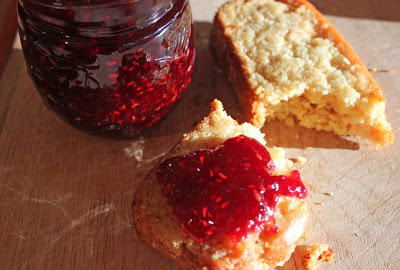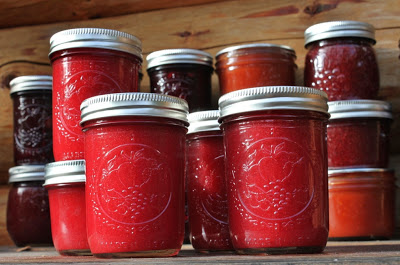This week, I emerged from the woods in Alaska with a pocket full of recipes for apples and cranberries, made on our two-burner propane stove. Those recipes — a butter, a sauce, and a conserve — will be coming soon, but today I’m looking back to mid-summer, when my pineapple sage was in full bloom and peaches from my neighbor Joanne were spilling across the kitchen counters, threatening to swamp anyone who got in their way. (He wouldn’t dare.)
This is a simple jam that will show off the flavor of your peaches, so use the most flavorful you can find. Before you begin, note that this is a two-stage process. You’ll need to prep your fruit and then let it macerate in the fridge for about 6-8 hours before you cook it down.
Peach Jam With Pineapple Sage
3 pounds ripe yellow peaches (weight before peeling)
2 1/2 cups sugar
2 tablespoons lemon juice
6 5-inch sprigs pineapple sage
1. Sterilize your jars and put 5 teaspoons on a plate in the freezer, to test your jam for doneness later.
2. Blanch the peaches by immersing them in a pot of boiling water for two minutes, then quickly transferring them to a bowl of ice water. (I like Julia’s trick for making this step easier: Use an ice pack instead of the loose stuff.)
3. Peel the peaches and roughly chop them into thick chunks.
4. In your jam pot, combine the peaches, sugar, and lemon juice. Bring to a simmer, then transfer the mixture into a glass or ceramic bowl. Gently stir in 3 of the pineapple sage sprigs and let it all sit in the fridge overnight. (Or prep in the morning and make your jam in the afternoon. Whatever suits you.)
5. After the mixture has macerated for 6-8 hours, remove the pineapple sage and pour the rest through a sieve into your jam pot. Now you have a pot full of wonderful sweet syrup. Set aside the peaches and bring the syrup to a boil. Cook until it thickens, about 5 minutes.
6. Add the peaches and the remaining pineapple sage sprigs to the syrup and return the mixture to a boil. After about 10 minutes, pull the sage from the pot, then continue cooking the mixture on high heat until your jam reaches the setting point (see below). As the jam cooks, use a shallow, stainless-steel spoon to periodically skim any stiff white foam from the top of the mixture. It took fewer than 15 minutes for this jam to cook for me, but keep in mind that lots of factors affect cooking time. Watch your mixture and test it carefully.
To test your jam for doneness: Remove the pan from the heat. Use one of your frozen spoons to scoop up a little bit of jam — not a whole spoonful. Return the spoon to the freezer and wait 3 minutes. Retrieve the spoon and hold it vertically. If the mixture runs very slowly or not at all, it’s done. (“Not at all” may be overdone, in fact.) Give the mixture a little push with your finger. If it clearly creases or wrinkles up, it’s done.
7. Ladle the hot jam into your sterilized jars and seal. Process 10 minutes in a water-bath canner.
Yields about 4 half-pint jars — and you’re done!
Because I’m posting this a couple of months after I made the jam, I have only one jar left. I just can’t bring myself to pop the lid just to take a picture of it. (If it weren’t such a nice jam, I’d have more of it to show you now.) Here’s the last jar, front and center with the five other kinds of peach jam I made in July and August.
And while I’m taking inventory, here’s a quick and kinda dirty shot of my end-of-summer jam cabinet, with my haul of peaches, blackberries, cherries, and — up there in the far left corner — pickled nasturtium pods.
Bring on the apples!









